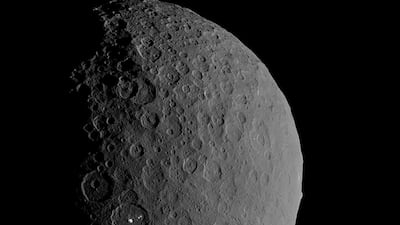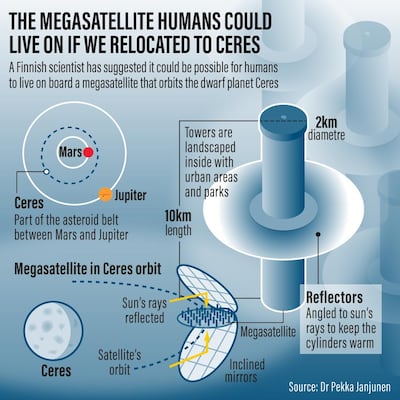If life on our virus-plagued, overheating planet is getting you down, a Finnish physicist has some good news.
The human race may be able to build itself a home elsewhere in the solar system. And it's not on the Moon or Mars.
What’s the big idea?
Visionaries have talked about colonising the solar system for centuries. Until now, most attention focused on setting up bases on the Moon and Mars. Elon Musk's SpaceX venture is testing its Starship rocket with the aim of settling both over the coming decades. But now a Finnish researcher claims to have found a much better place for our future home: Ceres.

Where on earth is that?
Actually, it’s a very long way from the Earth. Discovered in 1801, Ceres is a ball of rock in the asteroid belt, a region of cosmic rubble orbiting the Sun between Mars and Jupiter. Ceres once held the title of the biggest asteroid in the solar system, but astronomers now regard it as big enough to be called a dwarf planet, like Pluto. Even so, at barely 950 kilometres across – roughly the distance between Dubai and Riyadh – it is not huge.
So what’s the attraction of Ceres?
Part of it is precisely that – attraction. Both the Moon and Mars have a major drawback as long-term homes for humans: low gravity. Since the early days of space flight several health effects – particularly weakening of bones and muscle – have been linked to living in weightless conditions. While both the Moon and Mars have some gravity, it’s less than half that of the Earth.
The gravity of Ceres is far lower still, but now it’s being seen as the ideal place for a radically new type of home for humanity: a vast “megasatellite” orbiting the dwarf planet with inhabitable “spin driers” whose rotation creates artificial gravity. According to space technologist, Dr Pekka Janhunen, people could live and work on the inside walls of these gigantic spinning towers. Around 10 kilometres tall, each tower would be warmed by sunlight gathered and focused by vast mirrors, and landscaped inside with urban areas, parks and trees.
Is this for real? It sounds unbelievable.
Dr Janhunen is a scientist at the Finnish Meteorological Institute, Helsinki, whose work on space technology has been published in research journals. His research on the Ceres megasatellite is still in preprint form, but is backed by detailed scientific arguments.
But giant spinning towers – really?
The idea of creating artificial gravity through rotation is neither outlandish nor new. German pioneers of space travel came up with simple designs in the 1950s, and it was even tried aboard US Gemini spacecraft in the 1960s. The biggest problem will be familiar to anyone who has spent too long on a twisty road: nausea. But calculations by Dr Janhunen show that if the cylinders are wide enough – like two kilometres across – they can spin slowly enough to stay within safe limits. He estimates that tens of thousands of people could live in each cylinder in spacious surroundings.
Why can’t all this be done around the Moon or Mars?
It could – and at first glance, it would make a lot more sense. Even at its closest to Earth, Ceres is more than 230 million kilometres away – around four times the distance to Mars, and 600 times farther than the Moon.
But according to Dr Janhunen, Ceres has two main advantages. Studies suggest it could be mined for much of the material needed to build and sustain the megasatellite – including water, oxygen and nitrogen. Ironically, the small size and low gravity of Ceres also help, by making it easier to get the raw material up to the mega-satellite from the surface using a space elevator.

That sounds like another wild idea
It's actually another idea that's neither new nor entirely unrealistic. First proposed more than 120 years ago, it involves anchoring one end of a cable to the ground and connecting the other end to an orbiting object to keep the cable taut. Elevator cars then travel up and down the cable, giving a far cheaper way of getting into space than using conventional rockets.
In the case of Ceres, Dr Janhunen estimates the cable would have to be around 1,000 kilometres long. Once in orbit, the cars would leave the cable and travel on to the megasatellite orbiting another 100,000 kilometres from the dwarf planet.
Surely this can never be a replacement for the Earth?
Dr Janhunen admits there are still some big questions to be tackled – not least how to transport thousands of people safely to Ceres and the megasatellite. But according to his research, there is nothing to stop the celestial city from growing over time to accommodate billions of people.
Whether this grand vision becomes a reality will depend on detailed costings – and just how badly people want to leave the Earth.
The UAE's Mars Hope probe's launch into space – in pictures
Robert Matthews is Visiting Professor of Science at Aston University, Birmingham, UK

























